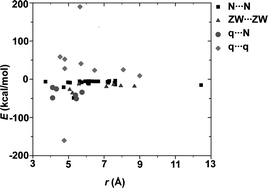The validity of the so-called strength–length correlation (“the shorter the contact, the stronger it is”) has been evaluated for short O–H⋯O contacts by correlating the MP2 interaction energy with the O–H⋯O distance. This correlation has been carried out for all the dimolecular systems that present short O–H⋯O contacts with the metric expected for hydrogen bonds, within the set of neutron diffraction crystals deposited in the Cambridge Crystallographic Database (CSD). Using the crystal geometry of these dimolecular systems and the 6-31+G(d) basis set, we calculated their MP2 interaction energy (corrected by the BSSE error). We also computed the components of that interaction energy using the IMPT method of Stone. No correlation is found between the MP2 interaction energy and the H⋯O distance when all dimolecular systems are analysed together. The IMPT analysis shows that this is due to the different nature of the interaction energy for charged fragments compared to that for neutral fragments. When the charge⋯charge dimolecular systems are discarded, the interaction energy of the remaining systems is found to follow a trend that roughly resembles the shape of the 1/rO⋯H2 or 1/rO⋯H4 curves (rO⋯H = H⋯O distance), although with very wide deviations. Consequently, one should only use strength–length correlations when the correlated dimolecular systems present a similar behaviour of their interaction energies with the distance.

You have access to this article
 Please wait while we load your content...
Something went wrong. Try again?
Please wait while we load your content...
Something went wrong. Try again?


 Please wait while we load your content...
Please wait while we load your content...